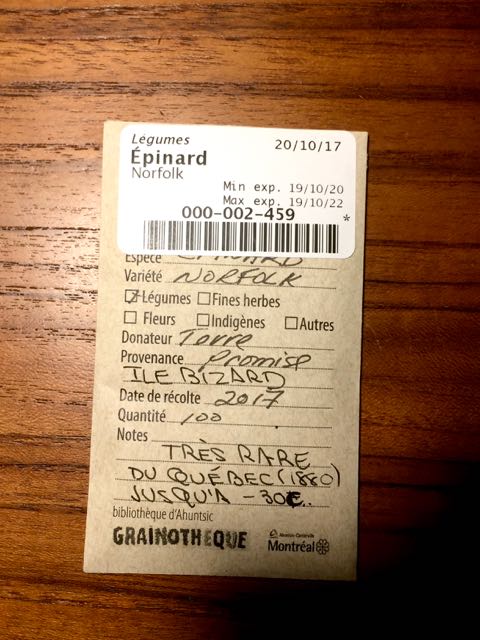Envelopes
Whether you get your original seeds from a commercial grower or a neighbor, LABEL! LABEL! LABEL! is the mantra. It is important to include the common name, variety, and year grown as an absolute minimum on the packets. However, there is much more that we can add to packets from stories about where the seeds came from to growing instructions and uses (ex. shelling, snap, or snow pea). Packet can have a personal touch with the addition of graphics. Here are a few envelopes from seed libraries. If you include information that isn't on any of these examples, please email us and we'll add it to our Notes from the Field section in our January issue so that everyone can benefit from your ideas and inspiration.
Pima County Public Library's Seed Library
Pima County, AZ, USA
Pima County Public Library's Seed Library
Pima County, AZ, USA
Grainothèque de la bibliothèque Ahuntsic (Ahuntsic Public Seed Library)
Montréal, Québec, Canada
Montréal, Québec, Canada
Appleton Seed Library
Appleton, WI, USA
We get them custom printed from Cambridge Pacific. I order with Sherry Barrett, [email protected].
They come gummed to self seal, lickable, or with no seal....depends on what you want.
It's lots of work handwriting the information. We wanted to have a personal touch, but it's not always fun trying to get 1000+ seed packs written each season.
Appleton, WI, USA
We get them custom printed from Cambridge Pacific. I order with Sherry Barrett, [email protected].
They come gummed to self seal, lickable, or with no seal....depends on what you want.
It's lots of work handwriting the information. We wanted to have a personal touch, but it's not always fun trying to get 1000+ seed packs written each season.
Greenfield Community College Seed Library
Greenfield, MA, USA
Greenfield, MA, USA
Community Seed Exchange
Sebastopol, CA, USA
The Community Seed Exchange collection is 100% locally grown and stored in jars. The jars have printed shipping label stickers on them. When people borrow seeds, they fill in their own label and stick it on an envelope.
Sebastopol, CA, USA
The Community Seed Exchange collection is 100% locally grown and stored in jars. The jars have printed shipping label stickers on them. When people borrow seeds, they fill in their own label and stick it on an envelope.
Richmond Grows Seed Lending Library
Richmond, CA, USA
We use a rubber stamp and hand stamp No. 1 and No. 6 coin envelopes. We have both in the seed library. The smaller ones are great for smaller seeds and seed swaps.
Things we've done to make labeling better:
Richmond, CA, USA
We use a rubber stamp and hand stamp No. 1 and No. 6 coin envelopes. We have both in the seed library. The smaller ones are great for smaller seeds and seed swaps.
Things we've done to make labeling better:
- created an envelope template that folks can type their information on. This is available on our website and we share it out in our community newsletter.
- put several copies of the labels in jars so folks have all the information they need. They just grab a label from the jar and stick it on or in the envelope.
- make labels for many varieties in our collection available online for folks to print out at home from our grow out sheet. This way people can print out a well made label with all the important information.
- bought two self-inking stamps: "Rare! Please save seeds." and "Crossed?" The first stamp highlights rare varieties and encourages folks to save them. The second stamp, "Crossed?", is because it's hard for us to save seeds from brassicas (ex. mustard, broccoli) and sunflowers. We mark all of those donated varieties from home gardeners as "Crossed?" to communicate to community members that they may not come out true-to-type. (See envelopes below.)
- label how many years we've grown the seed. For example, the first year we plant something, we'd mark the plant label as 16-0, which means we planted it in 2016 and the zero means that the seed came from an outside source. A label with 18-II, means that it was saved in 2018 and it is the second time we've saved seeds. (See envelopes below in the "Year" section.)
- include the "Super Easy" icon on peas, beans, lettuce, and tomato envelopes. (See image below on left packet.)
- include the "Hand Pollinate" icon on squash, melons, an cucumber envelopes.
- included appropriate quantities to take on the package: "Take a pinch. 1 Seed = 1 Plant." for small seeds and "Take 2-3 seeds for each plant you intend to grow." for larger seeds. (See envelope on the right-hand side.)
Tip 1 for Seed Libraries: Label! Label! Label!












